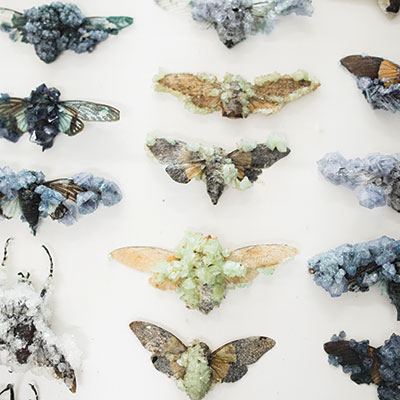Living thing
Making art at the end of the world
Crystallized snake skeleton by artist Tyler Thrasher.
Since 1970, the number of birds in North American skies has plummeted by nearly 3 billion. The findings published last month in the journal Science were dubbed a “full-blown crisis” by the National Audubon Society, but the numbers closer to the ground are just as disturbing. With researchers sounding the alarm of an impending “insect apocalypse,” monarch butterfly populations—for whom Oklahoma is a crucial migration path—have dropped by 90 percent over the last two decades due to habitat loss.
This is life in the anthropocene. That’s the million-dollar word scientists use to describe our current geological age of human activity. As climate predictions grow grimmer, promising far-reaching and unimaginable consequences across the planet, the quiet disappearance of the world’s flora and fauna serves as an eerie harbinger of a slow-motion mass extinction.
Tyler Thrasher’s art lives within that lopsided relationship between humans and the environment, but his preservation instinct looks a bit different than most conservationists. The 26-year-old artist and chemist documents a biosphere in decline through organic, crystalline sculptures that are both delicate and imposing—natural and otherworldly. Put more bluntly, he’s known in Tulsa and beyond as “the guy who crystallizes dead shit.”
The carcasses of rhinoceros beetles, cicadas, snakes, scorpions, shoreline crabs and more litter Thrasher’s custom-built studio in the back of his longtime friends’ STEMcell Science Shop on Admiral Boulevard. He’s been working here as the retail store’s “scientist in residence” since last October, when the shop outgrew its space in The Boxyard and moved to the Kendall Whittier neighborhood. Vats of chemical solutions line the west wall of his fully-functional lab: some with submerged corpses of insects sprouting crystalline growths, others opaque with mystery sludge caused by various air-to-solution reactions.
 “I’ll prepare a solution and soak the insect. Then as the water evaporates and the whole thing cools down, those ions can slow down enough to start re-forming those bonds. And those bonds are what start to make the base of the crystalline structure,” Thrasher explains. “My job is to put, say, a cicada between those micro-crystals. And so when they fall onto the cicada and attach to it, they’ll start to form these electrical currents that pull in more molecules and enhance that crystal structure.”
“I’ll prepare a solution and soak the insect. Then as the water evaporates and the whole thing cools down, those ions can slow down enough to start re-forming those bonds. And those bonds are what start to make the base of the crystalline structure,” Thrasher explains. “My job is to put, say, a cicada between those micro-crystals. And so when they fall onto the cicada and attach to it, they’ll start to form these electrical currents that pull in more molecules and enhance that crystal structure.”
Thrasher pulls out a finished work: a pastel orange-pink crab covered in shimmering off-white crystals. It looks like a creature from a dream, ghostly and beautiful. But where others might see subconscious fantasies of another world, Thrasher sees a science project. “The crabs are a lot of fun because they have all these joints and crevasses where crystals can get in and nucleate,” he says. A broad grin stretching across his face, Thrasher’s joy in the process is palpable and infectious, bringing his high-altitude scientific ambitions down to earth where they can be appreciated as tangible objects of beauty and wonder.
“I get [specimens] from all over. When it’s cicada season, my wife and I will go climb trees and get the little cicada shells, or I find them dead on the sidewalk before the ants get to them. I work with entomologists that send me their old collections. I’ve had people send me their old drawers and they’re like, ‘Here. I’m doing nothing with these dead bugs.’ People send me skulls and dead bugs all the time,” he says with a laugh. “They just kind of, like, come to me.”
Thrasher trades the sparkling dream crab for a jet-black scorpion encrusted in crystal clusters, its barbed tail curved in striking position, along with a coating of what looks like a fine gray dust. “This is one of my favorite crystals: iron ammonium sulfate. The iron will oxidize, so you’ll get these crusty impurities that I enjoy, because it looks more like a found object than this clean, pristine lab-grown thing.”
This tension between the immaculate and the imperfect, between chaos and control, is part of what makes Thrasher tick. On this front, his work strikes a delicate balance. “I can take these insects and submerge them, and when I pull them out, I have no idea—I mean, I can get pretty close and assume what’s happening in the vats—but sometimes it’s almost completely unpredictable: how large the crystals are, how many there are, what the piece looks like,” he says. “I can put five pieces in the same vat and they’ll all come out a little different. So there’s definitely a sweet spot between predictable controlled science and art, where you just let it go and enjoy the outcome.”
* * *
Thrasher’s curiosity was sparked while earning his BFA in computer animation at Missouri State University—“which I don’t use at all,” he’s quick to point out. In his free time, he taught himself about science and the environment during frequent caving and hiking excursions throughout the Show-Me State, which boasts 6,300 recorded caves and counting.
The labyrinthine rock formations of our neighbors to the east are where Thrasher first felt the pull of the natural world. His maiden underground excursion to Skylight Cave, a submerged “lava tube” about three hours east of Tulsa, lit the spark that would carry him to dunk his first cicada in a bath of copper sulfate a half-decade later.
“The whole time I was down there, I was thinking, ‘How many people have been in this cave? How far back does it go?’ We saw a tunnel that had collapsed and broken down, and the guide said this part hasn’t been mapped because no one could get past this breakdown. And I’m thinking, this cave could go on for five more miles and no one knows it!’”
 That spirit of exploration, of re-mapping the boundaries of what’s possible in science and art, drives Thrasher’s work to this day. He points to a 16-foot-long articulated python skeleton which will be submerged in a custom-built vat to produce the largest work of his career. After that, he hopes to create the world’s first opalized insect, a project currently in its developmental stages. Thrasher retrieves a specimen jar containing a submerged cicada, sporting patches of the hydrated amorphous form of silica, lending a subtle, psychedelic sheen to the prehistoric bug.
That spirit of exploration, of re-mapping the boundaries of what’s possible in science and art, drives Thrasher’s work to this day. He points to a 16-foot-long articulated python skeleton which will be submerged in a custom-built vat to produce the largest work of his career. After that, he hopes to create the world’s first opalized insect, a project currently in its developmental stages. Thrasher retrieves a specimen jar containing a submerged cicada, sporting patches of the hydrated amorphous form of silica, lending a subtle, psychedelic sheen to the prehistoric bug.
“I’m finding my approach towards the natural world has drastically changed—from college, when I seemingly didn’t know to give a shit,” he says. “I started getting into this work and learning more about insects. I’m not an entomologist at all. Had no prior knowledge of insects. But I knew I wanted to work with them in this series. So I found myself learning about their cycles and their importance.”
Triggering that same wonder and curiosity about the natural environment, especially for younger generations, is a big part of Thrasher’s goal as an artist. “Looking at the world, and how we’re severely fucking it up—I keep thinking of all these kids. They come in here, and they see art and chemistry and science together. They see something they may have never seen before,” he says. “It sparks their curiosity, and then they’ll ask me, ‘Do you just do this for fun?’ And I’m like, ‘Yeah!’ And then it kind of shows that science is something that is accessible. You can do crazy exciting things with it. Which I think is a segue for young curious minds and kids to care about science—to care about insects.”
As we surrender more and more of our natural world to the jaws of the climate crisis, Thrasher’s crystallized creepy-crawlies take on a new shade of reverence—a sort of elegy for a vanishing ecosystem, urging us to slow down, observe the environment around us, and consider our place within it. “These are things most people kind of just trot right over,” he says, gesturing to the specimens scattered throughout his workspace. “I want to pull this stuff out and show people, ‘Look how fucking cool the world is!’”


.jpg)
.jpg)
